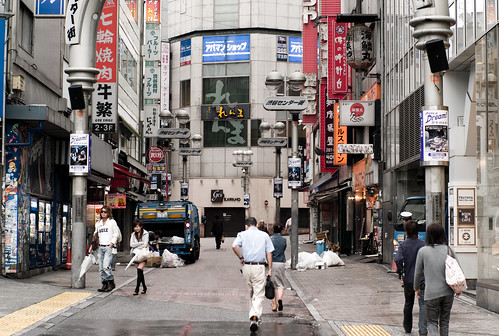Finding the House
Wireless Watch from Japan, Inc. has a story, "The Navigation Bubble," about the mobile maps market in Japan. Not surprisingly, given the difficulty of specifying Tokyo addresses (which are usually not numbered linearly with the flow of the street, may not have names, and where locations are provided through neighborhood designations), map making is a well practiced endeavor, and the leading map company, Zenrin, has been in the forefront of expanding the use of locational products. (It is worth noting that Japanese mobile phones have rich, GPS-enabled locational and directional services).

Shibuya. Photo by Joi Ito 2007 (CC BY/2.0).
The Wireless Watch article states:
Japan has been leading the in-car navigation industry. Maps are a pure necessity in Japan - it is easy to get lost as streets have no names. Most of the vehicles nowadays are sold with high-end built-in navigation units of which the maps are supplied by leading mapmaker Zenrin, a Kyushu-based company.
At the Zenrin web site (the English version), it is eye-opening to read about the various product offerings. Obviously, the detail required to meet Japanese expectations is high:
Our detailed maps feature the names of each building and residence, as well as roads and traffic information such as street names, bus stops, traffic lights and one-way streets.
There is also evidently a degree of information centralization that would be difficult to achieve within the United States, or I suspect, most other states, where geo-reference information tends to remain viscously within vertical data application silos.
ZENRIN maps are widely used by local governments and public utility companies. We provide these bodies with diverse maps from fire department maps to electricity, gas, sewage and telecommunications maps that specify pertinent information. For example, the fire department maps clearly indicate the location of fire hydrants and storage facilities for dangerous materials.
This kind of intensely detailed mapping makes one contemplate the rich set of derivative applications that one might evolve, and definitely points the way to the deeper embedding of locational information in software-based knowledge systems.
It is intriguing to think about how the ready availability of this public infrastructure data could be integrated into newer conceptions of architectural design, engineering, and construction, such as Building Information Modeling, with attempts to integrate consolidated building information into other relevant datasets including utilities, First Responders, and so forth. The standards here are nascent and many, but there may be eventual clarification as the benefits are obvious and compelling (speaking as someone who was living on the southern edge of Greenwich Village in September 2001).
tags: publishing
| comments: 2
| Sphere It
submit: ![]()
![]()
![]()
![]()
0 TrackBacks
TrackBack URL for this entry: http://blogs.oreilly.com/cgi-bin/mt/mt-t.cgi/5940
Comments: 2
Post A Comment:
STAY CONNECTED
RECENT COMMENTS
- nop on Finding the House: id numbers on street li...
- Steven Veltema on Finding the House: My company does some wo...


Steven Veltema [10.16.07 01:09 AM]
My company does some work for Zenrin and while I can't state the nature of that work, the amount of data that is collected by Zenrin is simply incredible.
As an example, all street lights, telephone poles, power pylons etc throughout the country have an id number. This number is used by emergency responders to quickly local accidents, disasters etc, particularly where GPS is not available and the location is in a remote area.
Home and business owners in Japan are sent out surveys every few years requesting information on the occupants (name, number, ages etc). The information is strictly voluntary and it is possible to opt out and/or request deletion, but this information is then also given out to emergency responders. Ownership information is given out to realtors. Name information used to be given to businesses (think pizza delivery, or UPS) to help make deliveries more accurate, but with the tightening of privacy laws here, I believe (uncertain) this has stopped.
Zenrin retains a small army of investigators (I have seen numbers around 300,000 mostly part timers) going across the country and door to door to continuously keep the database up to date.
Another idea of the detail of these maps, the precise outline (vector data) of my house and even the small shed in my back yard is viewable in Google Maps (which is supplied by Zenrin) and car navigation systems. Think of this on a national level and you get some idea of the level of detail these maps are.